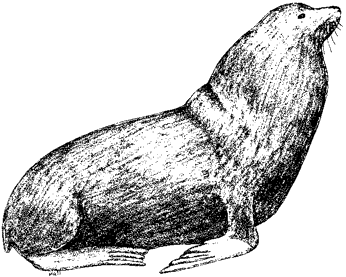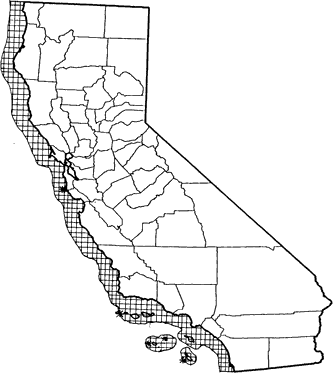
California Sea Lion
Distribution, Abundance, and Seasonality
The most abundant pinniped in California waters; over 50,000 are found on California islands and along entire mainland coast (Bonnell et al. 1978, Le Boeuf et al. 1983). Commercially hunted nearly to extinction in the late-1800's, population in California has increased dramatically since 1930's. At sea, found in pelagic and nearshore waters to surf zone. On land, rest and breed in groups of various sizes; on California islands, often found in large rookeries containing thousands of animals. Haul out on offshore rocks, sloping rock outcroppings, sandy and cobblestone beaches, jetties, and buoys. Sometimes travel up rivers and bays. Breed May to August in concentrated rookeries on Channel Islands and in Mexico. Males migrate northwards after breeding season, while females and pups generally remain near breeding rookeries. Females rarely give birth north of San Miguel Island.

Range Map
Specific Habitat Requirements
Feeding: Feed opportunistically on fish and cephalopods, including Pacific whiting, rockfish, anchovy, hake, flat-fish, small sharks, squid, and octopus (Keyes 1968, Morejohn 1977, Antonelis et al. 1981). Frequently forage in groups, which may increase in size with increasing size of prey schools (Fiscus and Baines 1966). Capable of dives to 250 m (820 ft) under experimental conditions (Ridgway 1972). Typical dives last 3-7 min; dives of 20 min have been recorded.
Cover: In the water, often observed in small groups swimming rapidly, "porpoising," surfing waves, or resting on surface with flippers extended. On land, occur in small groups and dense rookeries during breeding and non-breeding seasons.
Reproduction: Females give birth and nurse on land, entering water alone, or with pup, for thermoregulatory purposes, and alone during feeding trips. Mating takes place in the water and on land on all substrates (Peterson and Bartholomew 1967, Heath 1981).
Water: Freshwater requirements are met through metabolic processes and food (Pilson 1970, Harrison and Kooyman 1968).
Pattern: Prefer haul-out and breeding sites with nearby food supply, and easy access to water where human disturbance is minimal. Large groups may be frightened into the water by the appearance of a person.
Species Life History
Activity Patterns: Yearlong, circadian activity pattern.
Seasonal Movements / Migration: Annual migratory movements of males occur: southward to breeding rookeries in Channel Islands and Mexico in spring, and northward in late summer following breeding season. A–o Nuevo Island and the Farallon Islands provide major haul-out grounds for males throughout the year (Orr and Poulter 1965, Le Boeuf and Bonnell 1980). Little is known of female migratory movements, although they appear to remain near breeding rookeries (Peterson and Bartholomew 1967, Odell 1981).
Home Range: No information found.
Territory: Adult males maintain terrestrial and aquatic territories in breeding season. Territorial boundaries, often fluid and unstable, nearly always extend to water and often into deep water (Heath 1981).
Reproduction: Breed May to August. Highly polygynous, adult males establish and defend territories. Preferred territories contain highest number of females, and controlled by largest breeding bulls. Males maintain territories for 2-6 wk. Most apparently fast during this time (Odell 1981). Females give birth to a pup 1-2 days after arrival, come into estrus and mate about 2 wk following parturition. Gestation probably 11 mo, and implantation appears delayed (Odell 1972). Mothers begin to leave the pup at 4 days of age, making progressively longer feeding trips at sea. Lactation lasts for several mo; mother-pup bond may persist for a yr or longer (Peterson and Bartholomew 1967).
Niche: Preyed on by great white sharks, but apparently less frequently than California phocids (Le Boeuf et al. 1982). Killer whales (Orcinus orca) also prey on sea lions. Accumulation of nitrogen compounds from large rookeries enriches nearby waters. A variety of diseases occur including leptospirosis and SMSV, which is similar to swine virus in domestic animals (Mate 1978, Odell 1981).
Sources & References
California Department of Fish and Game, 1999.
California's Wildlife, Sacramento, CA.
Written by: M. L. Riedman, reviewed by: H. Shellhammer, edited by: J. Harris, R. Duke
Antonelis, G. A., C. H. Fiscus, and R. L. DeLong. 1981. Late spring and summer prey of California sea lions, Zalophus californianus, near San Miquel I. California, 1978-1979. Page 3 in Procs. Fourth Biennial Conference on the Biology of Marine Mammals, San Francisco, Calif. 127pp. Bartholomew, G. A. 1967. Seal and sea lion populations of the California Islands. Pages 227-244 in R. N. Philbrick, ed. Proceedings of the symposium on the biology of the California Islands. Santa Barbara Botanic Garden, Santa Barbara, Calif. 363pp. Bonnell, M. L., B. J. Le Boeuf, M. O. Pierson, D. H. Dettman, and G. D. Farrens. 1978. Pinnipeds of the southern California Bight. Pages 1-535 in Marine mammal and seabird surveys of the southern California Bight area, 1975-1978. Bureau of Land Management, Dept. of Interior Contract AA550-CT7-37, Govt. Printing Office, Wash., DC Fiscus, C. H., and G. A. Baines. 1966. Food and feeding behavior of Stellar and California sea lions. J. Mammal. 47:195-200. Harrison, R. J., and G. L. Kooyman. 1968. General Physiology of the Pinnipedia. Pages 211-296 in R. J. Harrison, R. C. Hubbard, R. S. Peterson, C. E. Rice, and R. J. Schusterman. eds. The behavior and physiology of pinnipeds. Appleton, Century-Crofts, NY. 411pp. Heath, C. B. 1981. Breeding system variability in the California sea lion, Zalophus californianus. Page 52 (abstract) in Procs. Fourth Biennial Conf. on biology of marine mammals. San Francisco. 127pp. Keyes, M. C. 1968. The nutrition of pinnipeds. Pages 359-395 in R. J. Harrison, R. C. Hubbard, R. S. Peterson, C. E. Rice, and R. J. Schusterman, eds. The behavior and physiology of pinnipeds. Appleton, Century-Crofts, New York. 411pp. Le Boeuf, B. J., and M. L. Bonnell. 1980. Pinnipeds of the California islands: abundance and distribution. Pages 475-493 in D. Power, ed. The California islands. Santa Barbara Mus. Nat. Hist. 787pp. Le Boeuf, B. J., M. L. Riedman, and R. S. Keyes. 1982. White shark predation on pinnipeds in California coastal waters. Fish. Bull. 80:891-895. Le Boeuf, B. J., D. A. Aurioles, R. Condit, C. Fox, R. Gisiner, R. Romero, and F. Sinsel. 1983. Size and distribution of the California sea lion population in Mexico. Proc. Calif. Acad. Sci. 43:77-85. Mate, B. R. 1978. California sea lion. Pages 172-177 in D. Haley, ed. Marine mammals of Eastern North Pacific and Arctic waters. Pacific Search Press, Seattle, WA. 256pp. Morejohn, G. V. 1977. Feeding ecology of marine mamals in Monterey Bay, California. Abstract. Page 61 in Proc. second conf. on the biology of marine mammals, San Diego, Calif. Odell, D. K. 1972. Studies on the biology of the California sea lion and the northern elephant seal on San Nicolas Island, California. Ph.D. Thesis, Univ. California, Los Angeles. 168pp. Odell, D. K. 1981. California sea lion - Zalophus californianus. Pages 67-97 in S. H. Ridgway and R. J. Harrison, eds. Handbook of marine mammals, vol. 1. Academic Press, London. 235pp. Orr, R. T., and T. C. Poulter. 1965. The pinniped population of A–o Nuevo Island, California. Proc. Calif. Acad. Sci. 32:377-404. Peterson, R. S., and G. A. Bartholomew. 1967. The natural history and behavior of the California sea lion. Am. Soc. Mammal. Special Publ. No. 1., Lawrence, KA. 79pp. Pilson, M. E. Q. 1970. Water balance in California sea lion. Physiol. Zool. 43:257-269. Ridgway, S. H. ed. 1972. Mammals of the sea. Thomas Publ. Co., Springfield, IL. 812pp.
California Animal Facts | California's Wildlife